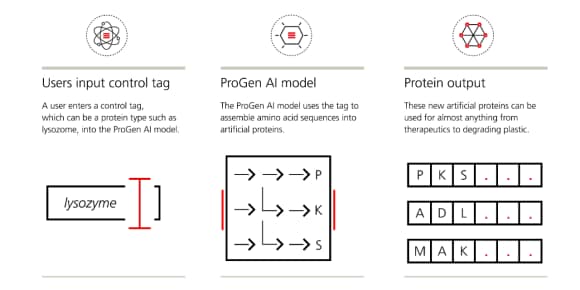How does AI change drug discovery?
AI tools have the potential to revolutionize drug discovery by enabling researchers to analyze large-scale data sets, design new molecules, and improve efficacy of clinical trials.

Key takeaways
Key takeaways
- Bringing a new pharmaceutical drug to the market is a notoriously costly and time-consuming process
- AI tools, such as ProGen and AlphaFold, offer enormous potential to speed up drug discovery
- AI is currently used at nearly every stage of the drug discovery process, including target identification and molecular simulations, prediction of drug properties, designing never-before-seen drug molecules, and clinical trials
At Nvidia’s Global Technology Conference in March 2024, CEO Jensen Huang outlined a bold vision for the role of artificial intelligence (AI) in healthcare: “For the very first time in human history, biology has the opportunity to be engineering, not science.”1 A few months later, in May, Google’s DeepMind released AlphaFold 3 – the most accurate AI model for predicting protein structure and biomolecular interactions developed so far.2 Some researchers think it will democratize structural-biology research and revolutionize drug discovery.3
Challenges of drug discovery
Challenges of drug discovery
Drug development is traditionally a lengthy and expensive process, which requires a great deal of effort. It often takes a decade and costs billions of dollars – lost in unsuccessful clinical trials – to bring a drug from a lab to the market. Utilizing AI can help make the process more efficient, as it is increasingly being introduced to each step of new drug discovery: from target identification and lead compound discovery to clinical trials.
In quest of more druggable targets
In quest of more druggable targets
Drug development starts with picking the right target – usually a protein that is directly associated with a disease. Thousands of targets have been discovered using biological or biochemical methods; some of them have revolutionized medicine, for example, the discovery of the PD-1 pathway led to the emergence of PD-1 checkpoint inhibitors, a milestone in cancer immunotherapy.
Despite the impressive number of drug targets discovered so far, it is estimated that – given the current level of understanding the genotype-phenotype relationships and available modalities – only around 5% to 15% of those targets are druggable, i.e., able to be therapeutically modulated by medicines.4 AI could help bridge this gap by analyzing vast genomic databases and producing new biological insights into molecular pathways or genetic links. This can lead to the discovery of new or better targets for drug development. AstraZeneca, for example, uses large-scale gene editing screening to modify genes in genomes and search for phenotypic outcomes that mimic desired drug effects on cells, tissues, organs, and the entire body.5
Novel modalities and molecules
Novel modalities and molecules
Once the target is identified, the next step is finding a molecule that binds to it. When the surface of a protein is too smooth and has no pockets, it is difficult for drugs to bind. Another problem could be that the identified target may in fact serve as a linker between other protein domains, which underlies complex mechanisms that we still do not understand very well. These targets are viewed as “undruggable”.
In recent years, new modalities have been developed to target the “undruggable” proteins, such as antibodies, cell and gene therapies, peptides, PROTACs (Proteolysis-Targeting Chimeras), to name a few. Using computer simulation, AI can improve the process of lead molecule selection by predicting the properties of this molecule in a much more precise way. If no desired molecule is available, AI models are now able to design molecules that have never been seen in nature, equipping them with desired pharmacological properties.
Decoding the language of proteins to enhance their properties
Decoding the language of proteins to enhance their properties
Proteins have their own (programming) language. As researchers nicely put it, “protein sequences can be described as a concatenation of letters from a chemically defined alphabet, the natural amino acids, and like human languages, these letters arrange to form secondary structural elements (“words”), which assemble to form domains (“sentences”) that undertake a function (“meaning”).”6
Using natural language processing (machine learning to reveal the structure and meaning of language datasets), it is now possible to "reverse engineer" proteins so that they have specific properties and functions. AI programs such as Salesforce’s ProGen are capable of assembling amino acids sequences into artificial proteins that do not exist in nature when instructed to find a protein with specific features, e.g., with “fewer side effects”.
ProGen and AlphaFold help design new proteins
ProGen and AlphaFold help design new proteins
ProGen “learnt” the protein language based on a database of amino acids in hundreds of millions of different proteins. The artificial proteins are “grammatically and semantically” naturalistic and exhibit potent bioactivities, according to the researchers.7 Another AI program, AlphaFold, is able to predict a protein’s 3D structure from its amino acid sequence. Interestingly, researchers found that “artificial designs perform much better than those inspired by the evolutionary process”.
Picture 1: AI-enabled protein design

AI improves designing and conducting clinical trials
AI improves designing and conducting clinical trials
Integrating AI into clinical trials can greatly improve their efficiency and accelerate the overall process. AI can analyze electronic medical records and other patient data to identify potential candidates. Biosimulation models use pattern recognition to optimize dosing, predict drug interactions, and drug efficacy. Finally, AI has proven to be an excellent tool in addressing regulatory questions when drugs go through regulatory agency approval.
Moderna, the biotech company famous for developing one of the COVID-19 vaccines, has created 750 GPTs8 to help facilitate internal tasks and processes. Moderna’s CEO Stephane Bancel holds high hopes for AI: “… we use it at scale to reinvent all of Moderna’s business processes, in science, in legal, in manufacturing – everywhere.”9
The concept of modularity in biology
The concept of modularity in biology
The emergence of technologies such as genomic sequencing and the subsequent gene-editing tools makes biology conceptually resemble engineering. From this perspective, nucleotides are assembled into DNAs, amino acids into proteins, proteins into cells, and cells into organs. Imagine each biology module – whatever size it is – having distinct properties and functions. Once these modules are fully understood, can we build biology just like we build Lego?
Turning biology into engineering
Turning biology into engineering
Although still early, AI has already delivered promising results. It has been successfully employed at various stages of clinical trials in drug development, helped us to understand human biology, created novel molecules, and even designed clinical trials. AI’s potential will only grow as it continues to be trained on ever-expanding datasets. The true impact of AI will only come to light when AI-designed drugs successfully complete clinical trials. Until then, skepticism may linger.
While it might sound like science fiction, the idea of turning biology into engineering is conceptually intriguing. For some AI protagonists, the arrival of AGI (Artificial General Intelligence)10 is just around the corner. We have good reasons to believe the next decade could be particularly exciting for medicine and biology, creating a wealth of attractive investment opportunities.
About the author

Fang Liu
CFA, Portfolio manager, Thematic Equities
Fang Liu (MA, CFA), Director, is a Senior Portfolio Manager of the Digital Health Equity strategy. Fang joined the Thematic Equity team in 2020. Prior to this, she worked at Calibrium AG for three years and covered global equities across all sectors, and from 2015 to 2017, she was an equity analyst for thematic funds at Lombard Odier. She started her career in 2011 as an academic researcher at IMD, focusing on corporate strategy and innovation in the consumer, technology, media, and telecom sectors in China and Europe. Fang holds a master’s degree in Management from the University of Lausanne (HEC), has coauthored a book on globalization, and is a CFA charterholder.
Make an inquiry
Fill in an inquiry form and leave your details – we’ll be back in touch.
Introducing our leadership team
Meet the members of the team responsible for UBS Asset Management’s strategic direction.

